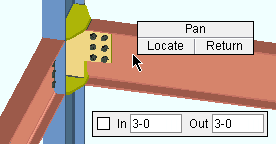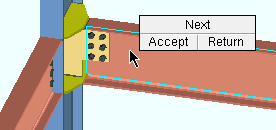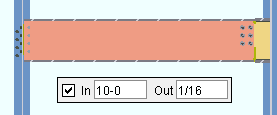 Snap to Farside Surface ( Modeling )
Snap to Farside Surface ( Modeling )
Tool summary :
- See the step-by-step instructions .
Also see :
- Adjacent/Farside Depth (option for Snap to Farside )
- Undo View Change (undoes Snap to Far Side )
- Snap to Surface (similar to Snap to Far Side )
- Snap to Adjacent Surface (similar to Snap to Farside )
page 1 | contents | navigate > surface > | navigate -- surface mode | 3D evus
Step-by-step instructions :
The following instructions assume that you are using a 3-button mouse and that you use mouse bindings similar to those shown in these illustrations. Also, performing this same operation in Surface Mode combines steps 1 and 2.
|
|
1 . Invoke Snap to Farside Surface . |

|
2 . Place your mouse pointer ( |

|
3 . Left-click ( Accept ) if the surface outlined with a blinking, cyan border is the surface you want. Or middle-click ( Next ) if you want a different far-side surface. |

|
4 . Snap to Farside puts you on the far side of the surface that you accepted in step 3. Depth checking is adjusted per User and Site Options > Modeling > Snap to adjacent/farside . |
Note 1: To invoke Snap to Farside Surface ...
Method 1 : Click the Snap to Farside Surface icon, which is pictured above. The icon can be taken from the group named ' Navigate -- Surface Mode ' and placed on a toolbar (classic) or the ribbon (lightning).
Method 2 : If " Modeling layout style " is ' Classic ', you can use the menu system to choose Navigate > Snap to Farside Surface .
Method 3, 4 or 5 : Snap to Farside Surface can also be configured to be invoked using a keyboard shortcut , the context menu , or a mode . For the lightning interface, this configuration is done using Customize Interface .
Method 6 : You can Snap to Farside from Surface Mode . First place the mouse pointer (
) on the surface of the material you want to snap to, then middle-click ( Far Side ). In the above instructions, skip step 2 and go to step 3.
Note 2: Right-click ( Return ) in steps 2 or 3 ends the Snap to Farside operation.
Note 3: Middle-click ( Next ) in step 3 is for multiple parallel surfaces. For a tube , the program first takes you to the farthest parallel surface, then the next nearest parallel surface. If you middle-click ( Next ) after all possibilities have been shown, the program ends the operation.
Note 4: At this point you have not actually created a new view; you have simply relocated your current view. If you were to Open ( Ctrl + o ) your current view again, you would undo the changes made with this tool.
page 1 | contents | navigate > surface > | navigate -- surface mode | 3D evus | top